
Directed by Betty Thomas
Visual Effects Supervisor: Jon Farhat
Visual Effects Producer: Anne Putnam

Directed by Betty Thomas
Visual Effects Supervisor: Jon Farhat
Visual Effects Producer: Anne Putnam
BANNED FROM THE RANCH ENTERTAINMENT
POP FILM
COMPUTER FILM COMPANY/Los Angeles
C.O.R.E. DIGITAL PICTURES
PACIFIC TITLE/MIRAGE
RAINMAKER DIGITAL PICTURES
CINESITE
Review by Aladino V. Debert
Directed by Betty Thomas, this loose remake of the Hugh Lofting's charming children 1967 film, depicts Eddie Murphy as a doctor capable of talking (and listening) to animals. The effects workload, mostly in the form of talking animals, was handled by a collaboration among a variety of houses including VisionArt, POP Film, Banned From The Ranch, C.O.R.E Digital Pictures, Cinesite and The Computer Film Company. Jim Henson's Creature shop provided some full size animatronics and digital effects, as well.
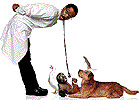 Visual Effects Produced by:
Visual Effects Produced by:
VISION ART
VFX Supervisor: Joshua Rose
VFX Supervisor: Van Ling
VFX Supervisor: Jennifer German
Contributing Writer
aladino@vfxhq.com
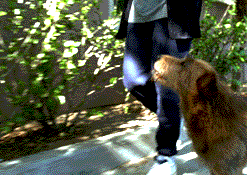 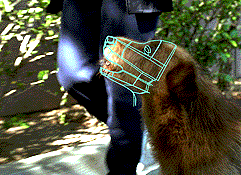 
One animal that was executed by VisionArt Design and Animation was Lucky the dog, voiced by Norm MacDonald. Utilizing 3D methods, VisionArt meticulously matchmoved a 3D wireframe over the real-life dog, then composited a 3D mouth over the original footage, but not before painting out the original jaw. The top left shot is a frame from the original footage, while the upper left is a frame from the 3D matchmove. The lower image is the final, color corrected composite. |
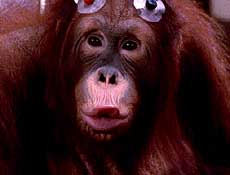 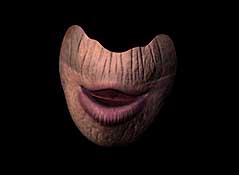 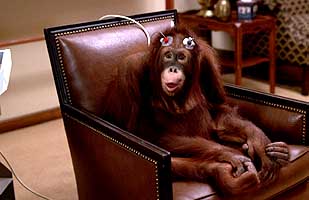
VisionArt Design and Animation gave voice to many animals throughout DOCTOR DOLITTLE, including the Latino orangutan that talks to Eddie Murphy. For this animal, VisionArt created and animated a CG mouth and lips for the animal, and tracked it over the real animal's mouth. At top left is a detail frame from the original photography; at top right is a detail of the CG mouth; and at bottom is the final composite. |
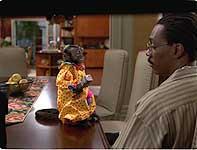 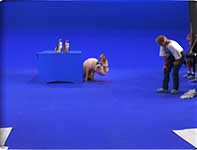 
The drunk monkey shots in DOCTOR DOLITTLE were handled by Banned From The Ranch Entertainment. As was the case for just about all the talking animal shots, this shot required not only the animation of the monkey, but the bluescreen extraction and compositing of background animals. The monkey was animated via 2D techniques in Adobe After Effects. |
The most remarkable aspect of the movie is the complexity and incredibly long duration of some of the effect shots. Most of these involve "Lucky", and one especially memorable shot shows the dog walking alongside Dr Dolittle. The dog's head nods up and down, side to side, but the tracking is sharp. Another sequence of shots worth describing contain a tiger. The 2D manipulated mouth is quite realistic and even takes into account the feline's long whiskers. The longest sequence involving animatronics also portray the tiger laying down on an operating table. Although it happens to be a slightly yellow tiger at that, the movements are as realistic as possible given the limitations of puppetry.
DOCTOR DOLITTLE, as many remakes lately seem to have a habit of being, is a big bore. But the seamless work of the special effects crew have made the numerous effect shots in the movie a joy to watch.
Check out Cinefex 75.
Official Web Site: http://www.drdolittle.com

. . VFX HQ Produced by Todd Vaziri . . http://www.vfxhq.com . . e-mail: tvaziri@gmail.com . .
All text Copyright © 1998 Todd Vaziri, unless otherwise noted